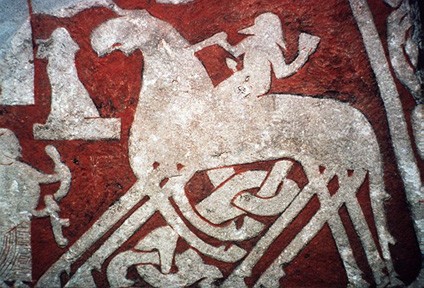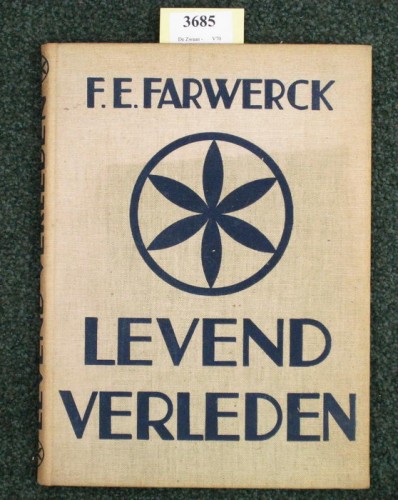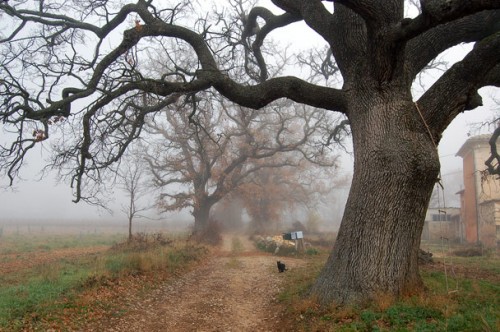
Frans Eduard Farwerck
by Roy
Ex: http:://www.new-antaios.net/
Some 8 years ago I met my girlfriend. We were both involved in a short-lived Dutch ‘spiritual magazine’ that liked to treat controversial subjects. Through the editor of the magazine my girlfriend got acquinted with a Flemish ‘Asatru’ group and later so did I. At the time my interest still mainly laid at Renaissance esotericism, Medieval magic, etc. This was already a bit closer to home, since before I had an interest in more exotic, Eastern subjects. In any case, meeting Asatru excelled my shift towards even more domestic interests, the old religion of Northern Europe. While becoming active in the group I initially sticked to my interests, but I heard a lot of interesting new paths.
In the Netherlands and Flanders we have a chain of fairly large antiquarian bookshops called “De Slegte” and at the time I frequently visited our local store. Nowadays I specifically hunt for titles instead of just seeing what I run into. Contrary to my habbits of the time, I took a look through the folklore/faery tales section and my eye fell on the back of an enormous, red book. I took it from the shelf, paged through it and I realised that this had to a be title often used by the founder of the Asatru group. Similar ideas, similar subjects. The back said: Noordeuropese Mysteriën. It was not cheap, but I bought it, read it and was blown away.
Since that time, this book has become a true cult-work among Dutch speaking heathens. The book has been out of print since 1978, but as there is demand for it, the price is pushed upwards. It has not yet become another Altgermanische Religionsgeschichte (Jan de Vries, 1956 and 1974, this two volume work is usually sold for several hundreds euros), but you do not just visit a (web)shop and buy it. Noordeuropese Mysteriën is not impossible to find and it does not even have to be really expensive, but you have to look around not to pay an absurd price for it, since especially after the internet catalogues of antiquarian bookshops, some people figured out what they can ask for the title.
Contrary to Altgermanische Religionsgeschichte, Noordeuropese Mysteriën is written in Dutch (De Vries’ book is in German), narrowing its audience. This and the fact that is no longer in print, caused the fact that the book is unknown and overlooked in the non-Dutchspeaking world, especially in the English-speaking world. I hope that this small article might change that. Of course, this might put even more pressure on the price, but perhaps a foreign publisher gets the idea of republishing or even translating it. But at least, people who ‘should’ know the book, might now hear of it.
The book I am talking about has the full title Noordeuropese Mysteriën en hun sporen tot heden. This is translated as ‘Northern-European mysteries and their traces to the present’. We know about the mystery cults of the mediteranean area, Greece, Egypt, etc.; we know about the mystery religions of the near and far east, but mysteries in Northern Europe? Was ancient Northern Europe not inhabited by stupid plundering barbarians? Some scholars even doubt our ancestors had a religion to start with, let along a mystery cult. This book shows us otherwise and shows more, much much more.
Noordeuropese Mysteriën is the result of a lifelong investigation and the result of a respectfull list of publications of the Dutchman Frans Eduard Farwerck who lived from 1889 to 1978. Farwerck was a succesfull trader of carpets and joined Freemasonry in 1918. It took a while before his first publication saw the light of day, in 1927 he published a book about the world’s mystery religions through a regular publisher, but under the obviously Masonic pseudonym B.J. van der Zuylen (“Zuylen” is an old way of writing “zuilen”, “pillars” and the initials of course refer to Boas an Jachin). This impressive 565 paged book gives but little room to Germanic and Celtic mysteries, but they are already present. Farwerck’s next book is a truly Masonic one about the Hiram myth, published by “the lodge”. Then the Germans raised to power, Farwerck joined the NSB (“nationaal-socialistische beweging”, the Dutch national socialist party) and he was expelled from “the lodge” in 1934 after a 16 year carreer in which he reached the absolute highest rank in his order.
With his national socialist friends he founded a publishing company called “Der Vaderen Erfdeel” (losely translated with “fathers’ heritage”) through which in 1938 he published his classic work Levend Verleden setting the tone for his later writings. Farwerck travelled extensively, making countless photos, investigating local myths, stories and folklore and ‘living past’ is a collection of mostly building and frontage symbolism, the origins of which he traces back to the prechristian past. Then a few years of silence follow.
Again as Van der Zuylen in 1953 Farwerck publishes Noord-Europese Mysteriën en Inwijdingen in de Oudheid (‘Northern-European Mysteries and Initiations in ancient times’), a rough version of his much later Noordeuropese Mysteriën. In the same year Farwerck published a book about that mysterious object that is nowadays called the “Frank’s casket” and after that the extremely interesting and (almost) impossible to find Noord-Europa, een der bronnen van de Maçonieke symboliek (‘Northern Europe, one of the sources of Masonic symbolism’ 1955). This little book contains information that Farwerck apparently did not want/dare to publish in his public publication, but roughly it represents the next step in his investigations that would lead to Noordeuropese Mysteriën.
This time under his own name, Farwerck again publishes about the mystery religions in general in 1960 and 1 year later follows the final result, the man’s magnum opus. It is sold out in no-time, but has but one reprint, since Farwerck’s war-past suddenly became an obstacle. The second printing did not sell too well either.
Unfortunately the war past is a big issue in these parts. Many authors with interest in the pagan past of Northern Europe thought that joining the national socialists could be good for their cause and after the disaster of WWII they all remained with an ineradicable stain on their persons. Some even kept the ideology, others realised their mistake, but the result remains that when some people started to raise questions about certain author’s past, they were banned. Their books were no longer printed or republished, new authors who had no war-past whatsoever cannot use these authors as their sources. The collective shame for the actions of some of our people have made investigations in the subject of the prechristian religion of Northern Europe virtually impossible. Even the standard works of Jan de Vries (1890–1964), no matter how highly acclaimed by scholars, are no longer availble. Ironically enough among scholars De Vries is popular enough to give him some credit, so his Edda translation can be found in most bookshops to this day and many authors cite him by lack of better sources. I do not expect a reprint, let alone a translation of the Altgermanische Religionsgeschichte any time soon. The same goes for Farwerck’s superb work.

But enough about all that, let us talk a bit about the ideas in the book. Of course in a small article in which I want to give a biography and summerise the findings of half a decade of investigations, I cannot go into much detail. I hope to present you just enough to sparkle your interest in the subject and/or inspire people to learn Dutch and/or do their own investigations.
Noord-Europese Mysteriën
Farwerck starts with describing “religious and mythical conceptions of the Germans concerning rites of initiation”. Death and the underworld, burial practices, life after death, imaginations of the dead. This is all information you can also find elsewhere, but it of course sets the tone, since the next part is about candidates for the Germanic God of initiation. Is it Wodan, is it Balder, is it Donar? Most extensively treated is Wodan/Odin. His connection to the dead (conform Mercury), his wolves, the eight-legged horse, hangings, offering rituals, the Einherjar, all elements that, put in the right perspective, could suggest Wodan has something to do with initiations. An entire chapter is dedicated to the wild hunt(er) that goes around the nightly sky in the Yule-period, Wodan with his legion of the dead. Farwerck quotes from folklore and local myths to show that the idea of the Wild Hunt(er) can be found from France to Norway and from Slavic countries to Ireland. Wodan in connection to fertility (and therefor again with the dead) is the subject of the next chapter. After this Farwerck starts looking for information about rites of initiation, and we are not talking about rites de passage in which a boy becomes a man and a girl a woman. The first story that comes to mind is of course the story of Balder’s death and resurrection, the second Odin hanging down the world tree and learning the runes or the hanging of king Vikarr by Starkadr, but first we go to another subject.
Männerbünde
After the groundbreaking work Kultische Geheimbünde der Germanen (‘cultic secret societies of the Germans’ 1934) the subject of “Männerbünde” (‘men bonds’) was ‘hip’ for a while. But… also Höfler became a member of the Ahnenerbe and the NSDAP so after WWII this was another subject ‘not done’. Only recently scholars start to write about the subject again. Even English writing scholars usually use Höfler’s term “Männerbünde”, so let us stick to that tradition. Männerbünde, as the term suggests, are groups of men that stand with one leg outside normal society, they are secret groups. In the context of Northern European peoples we quickly think about some sort of elite warrior groups such as the Einherjar, the Uldhednar and the Berzerkr, but Farwerck suggests that many of the names that we think were tribes in the writings of the Romans, actually referred to such elite warrior groups. The Harii, the Chattii, the Langobards, even the Vikings in the original meaning supposedly were such groups. Should the Männerbünde have been mere warrior groups, they would have not been as interesting as they are though.
When not at war, members of these groups had all kinds of special priviledges. The right of reprimand, the right to steal, they had certain dances, festivities, dressing (such as animal clothing) and special roles in public ceremonies for fertility or seasonal feasts. Many things suggest that members of these groups fulfilled a special role in society, a role which even came with obligations such as that of secrecy and several duties. Farwerck shows what he finds around these subjects and continues to show that such groups have survived much much longer than we may expect. They were cultic groups that survived the coming of Christianity by remodeling to Christian groups that we came to know as guilds. Besides such ‘religious guilds’, there were of course the famous workers guilds of the masons, the timbermen and the tanners, groups that have remarkable similarities to the Männerbünde of old.
Farwerck sums up a staggering amount of folkloristic habbits and other remains that are unmistakenly connected to these groups. All kinds of saints seem merely Christianisations of pagan deities and the traditions around them have but a thin layer of varnish. Horn– and Morrisdances, Mummer’s plays, sword dances, Schlemlaufen and Klausjagen, Farwerck lets a lot of these nice folkloristic feasts pass the reader. It is amazing how the stealright or the right to reprimand are still rights of youth-groups as late as the early 20th century, groups that have some watered-down element of wearing animal skin and certain dances that have been performed in churches until the Reformation. Of course much information comes from Christian sources trying to ban these pagan practices, but this often did not work too well so they were tried to be Christianised.
Reconstruction of ancient initiations
Chapter 10 is dedicated to the summing up of information that Farwerck has been able to find to see if he can reconstruct the rites. He starts with the possible places where the ceremonies would be held. Of course lakes, forrests, hills, etc. were the sacred places for Germans and Celts alike. There are many toponyms (place names) that suggest certain ceremonies. Murder pits, wolf pits, devil’s hills even “woensberg”en or places named “Woensel” (now part of the city of Eindhoven) and “Woensdrecht” all clearly refer to Wodan and in the case of the murder pits, could there death-and-resurrection ceremonies have been held? There are also toponyms that seem to refer to (sacred) meals (cultic meals?), so called “troja burchten” (constructions or drawings in the form of a spiral) about which a lot is to say (Farwerck uses 24 pages). Then we have the sacred times of the solstices and equinoxes around which (folk)stories exist that suggest cultic rites vague shadows of which have been kept in folklore and recent festivals. After this Farwerck comes to clothing, sacred weapons, certain songs and dances, hangings and spear-woundings, travels to the underworld and resurrections therefrom, new names, the sacred potion (usually something made with honey) and old and less old references to brotherhoods of all sorts.
Farwerck continues with guilds. Since they are fairly recent there is more information available about their structure, habbits, legal status, etc. Not only workers-guilds are spoken about, but also for example shooting guilds, a beloved subject for people who want to find the traces back to a further past.
With “building huts” and building guilds we are a step closer to our own time, because you will probably know that they are well represented in the history the Freemasons give themselves. Different kinds of guilds have all kinds of secrets that are both practical, but also religious. You can read all about it in the popular histories of Freemasonry, but Farwerck presents a nice overview and very interesting details. Now also follow more photos that Farwerck took in churches with faces with a hand below their chin, supposedly a secret sign of master masons. Of course there are also the master-signs (some sort of signatures) that often remind of runes, but we are already talking about the 11/12th century here. Quite some information about these guilds seems to come directly from Masonic writings, but of course, Masons says that these guilds are their predecessors. And then we get photos of all kinds of strange ornaments in churches with one-eyed figures (Wodan?), mockeries of the church, pictures of men in strange postures and all kinds of suggestive scenes that seem too unchristian to be built into a church.
Freemasonry
And there we have it, Farwerck spends the last 150 pages of his book showing that “Freemasonry [is] one of the youngest descendants of the ancient men bonds”. Having been a high-ranking Mason himself, he quotes all kinds of Masonic texts, rituals, etc. (but I think he tells us nothing he should better not) and compares them to what we find in myths, sagas, pagan art or folklore. The form of the temple, the place where the different officiants can be found, ritualistic symbolisms such as the limping or signs of recognition, symbolism on the “tableau”, the three pillars, the large and the small lights, Masonic clothing (Thor’s iron gloves and girdle), the consecrating hammer and even the opening and closing rites, they all seem to have Northern European origins rather than Jewish or Egyptian.
There is a lot more to say, but here you have the red thread. In working to his conclusion, Farwerck sheds light on a great many elements of folklore and (folk) symbolism, giving new interpretations of tales, sagas and texts that we know, cross referencing different myths and different folktales and all together his book is a true goldmine and a just reason to have grown into being a cult book. This is the kind of book that I hope to run into some time again, but I doubt I ever will. Besides all the works that I own of Dumézil, Eliade, Guénon or De Vries, I often first check Farwerck, then the rest. Especially when I am looking for visuals, I go to Farwerck, since his books are as much stuffed with photos and drawings as they are with information and until this day, he has collected an unprecedented amount of visuals of details and symbolism. These alone are a reason to get the book.
Even when you are not interested in the Northern European history of Freemasonry (most people who buy this book are not), you will find enough information in the uplighted parts that Farwerck needs to present his proof. Personally I admire the book too for being a non-Traditionalist, he presents a story that almost no Traditionalist has ever told even though (s)he should have: the unbroken chain has been kept in the West though Western organisations until this very day.






 del.icio.us
del.icio.us
 Digg
Digg


